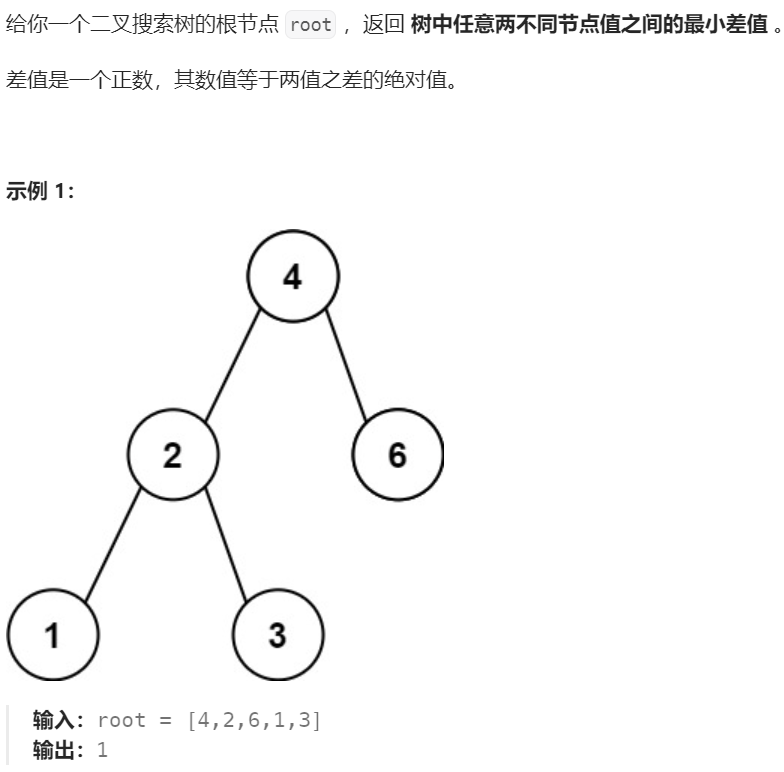代码随想录Day18
题目列表
- 530.二叉搜索树的最小绝对差(LeetCode)
- 501.二叉搜索树中的众数(LeetCode)
- 236.二叉树的最近公共祖先(LeetCode)
解题过程
530.二叉搜索树的最小绝对差
题目描述

解题思路
二叉搜索树采用中序遍历,得到的结果就是有序的,要求得最小的绝对差,需要遍历一整棵树,只要保证一直是后一个减前一个的值,就是差的绝对值。
递归函数参数与返回值:参数是树的节点,无返回值,因为最后的结果一定要遍历一整棵树才能得到记录。
终止条件:当前节点为 null .
递归逻辑:左中右的顺序;“中”的处理逻辑:准备一个全局变量节点 pre 保存前一个节点,然后判断当前节点与 pre 的值的差是否是最小。
代码展示
class Solution {
private int result = Integer.MAX_VALUE;
private TreeNode pre = null;
public int getMinimumDifference(TreeNode root) {
getMin(root);
return result;
}
public void getMin(TreeNode root){
if(root == null) return;
getMin(root.left);
if(pre != null){
result = Math.min(result, root.val - pre.val);
}
pre = root;
getMin(root.right);
}
}
501.二叉搜索树中的众数
题目描述

解题思路
这道题的核心逻辑在中间节点的处理过程:
首先要记录当前节点的出现次数,然后要根据当前节点出现次数 count 来更新最大出现次数 maxCount :
如果 count 大于 maxCount ,就说明有了出现次数更多的众数,那么之前记录的“众数”就应该丢弃,而当前节点的值成为新的众数,然后 maxCount 更新为 count。
如果 count 等于 maxCount, 就说明这是新的众数,添加到结果集即可。
代码展示
class Solution {
List<Integer> res = new ArrayList<>();
int maxCount = 0;
int count = 0;
TreeNode pre = null;
public int[] findMode(TreeNode root) {
find(root);
int[] result = new int[res.size()];
int i = 0;
for(int num : res){
result[i++] = num;
}
return result;
}
public void find(TreeNode cur){
if(cur == null) return;
find(cur.left);
//记录当前节点的count
if(pre != null && pre.val == cur.val){
count += 1;
}else if(pre == null || pre.val != cur.val){
count = 1;
}
pre = cur;
//更新最大count
if(count > maxCount){
res.clear();
maxCount = count;
res.add(cur.val);
}else if(count == maxCount){
res.add(cur.val);
}
find(cur.right);
}
}
236.二叉树的最近公共祖先
题目描述

解题思路
这道题要“从下往上”遍历,但第一个传入的参数是 root ,所以要将结果一直 return 到树的根节点,也就是需要回溯。
采用后序遍历,递归:
递归函数返回值类型与参数:因为要返回最低公共祖先,所以返回值类型是 TreeNode, 参数就是树的节点和 p 和 q .
终止条件:当前节点为 null ,或 p ,或 q.
递归逻辑:后序遍历,先是左子树,再是右子树,然后处理:
如果左子树和右子树的返回值都不是 null, 说明当前节点的左右子树中有pq,此时它就是这个祖先,返回自己。
如果其中一个为空,那么说明pq其中出现在左子树或右子树,出现在哪边,就返回哪边的孩子节点。
如果都为 null ,返回 null.
代码展示
class Solution {
public TreeNode lowestCommonAncestor(TreeNode root, TreeNode p, TreeNode q) {
if(root == null) return null;
if(root == p || root == q) return root;
TreeNode left = lowestCommonAncestor(root.left, p, q);
TreeNode right = lowestCommonAncestor(root.right, p, q);
if(left != null && right != null){
return root;
}else if(left == null && right != null){
return right;
}else if(left != null && right == null) {
return left;
}else{
return null;
}
}
}






 浙公网安备 33010602011771号
浙公网安备 33010602011771号